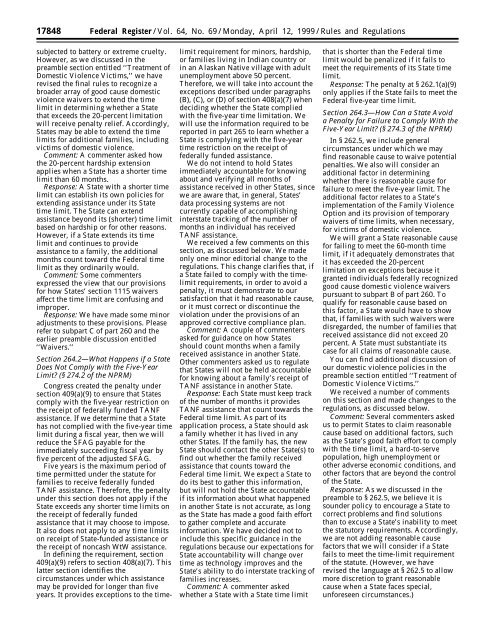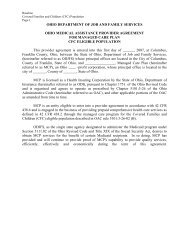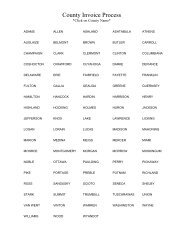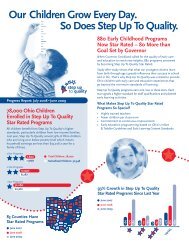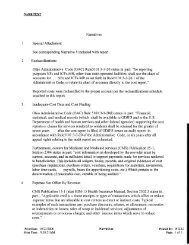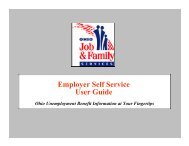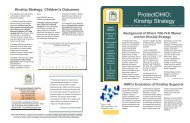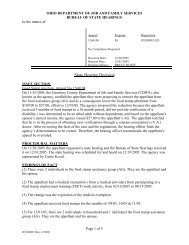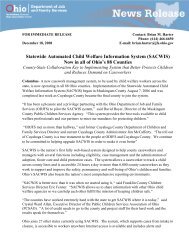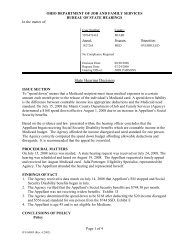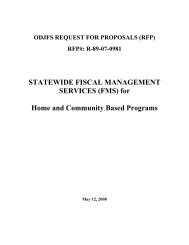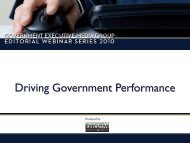Final TANF Rule as published in the Federal Register 4/12/1999
Final TANF Rule as published in the Federal Register 4/12/1999
Final TANF Rule as published in the Federal Register 4/12/1999
Create successful ePaper yourself
Turn your PDF publications into a flip-book with our unique Google optimized e-Paper software.
17848 <strong>Federal</strong> <strong>Register</strong> / Vol. 64, No. 69 / Monday, April <strong>12</strong>, <strong>1999</strong> / <strong>Rule</strong>s and Regulations<br />
subjected to battery or extreme cruelty.<br />
However, <strong>as</strong> we discussed <strong>in</strong> <strong>the</strong><br />
preamble section entitled ‘‘Treatment of<br />
Domestic Violence Victims,’’ we have<br />
revised <strong>the</strong> f<strong>in</strong>al rules to recognize a<br />
broader array of good cause domestic<br />
violence waivers to extend <strong>the</strong> time<br />
limit <strong>in</strong> determ<strong>in</strong><strong>in</strong>g whe<strong>the</strong>r a State<br />
that exceeds <strong>the</strong> 20-percent limitation<br />
will receive penalty relief. Accord<strong>in</strong>gly,<br />
States may be able to extend <strong>the</strong> time<br />
limits for additional families, <strong>in</strong>clud<strong>in</strong>g<br />
victims of domestic violence.<br />
Comment: A commenter <strong>as</strong>ked how<br />
<strong>the</strong> 20-percent hardship extension<br />
applies when a State h<strong>as</strong> a shorter time<br />
limit than 60 months.<br />
Response: A State with a shorter time<br />
limit can establish its own policies for<br />
extend<strong>in</strong>g <strong>as</strong>sistance under its State<br />
time limit. The State can extend<br />
<strong>as</strong>sistance beyond its (shorter) time limit<br />
b<strong>as</strong>ed on hardship or for o<strong>the</strong>r re<strong>as</strong>ons.<br />
However, if a State extends its time<br />
limit and cont<strong>in</strong>ues to provide<br />
<strong>as</strong>sistance to a family, <strong>the</strong> additional<br />
months count toward <strong>the</strong> <strong>Federal</strong> time<br />
limit <strong>as</strong> <strong>the</strong>y ord<strong>in</strong>arily would.<br />
Comment: Some commenters<br />
expressed <strong>the</strong> view that our provisions<br />
for how States’ section 1115 waivers<br />
affect <strong>the</strong> time limit are confus<strong>in</strong>g and<br />
improper.<br />
Response: We have made some m<strong>in</strong>or<br />
adjustments to <strong>the</strong>se provisions. Ple<strong>as</strong>e<br />
refer to subpart C of part 260 and <strong>the</strong><br />
earlier preamble discussion entitled<br />
‘‘Waivers.’’<br />
Section 264.2—What Happens if a State<br />
Does Not Comply with <strong>the</strong> Five-Year<br />
Limit? (§ 274.2 of <strong>the</strong> NPRM)<br />
Congress created <strong>the</strong> penalty under<br />
section 409(a)(9) to ensure that States<br />
comply with <strong>the</strong> five-year restriction on<br />
<strong>the</strong> receipt of federally funded <strong>TANF</strong><br />
<strong>as</strong>sistance. If we determ<strong>in</strong>e that a State<br />
h<strong>as</strong> not complied with <strong>the</strong> five-year time<br />
limit dur<strong>in</strong>g a fiscal year, <strong>the</strong>n we will<br />
reduce <strong>the</strong> SFAG payable for <strong>the</strong><br />
immediately succeed<strong>in</strong>g fiscal year by<br />
five percent of <strong>the</strong> adjusted SFAG.<br />
Five years is <strong>the</strong> maximum period of<br />
time permitted under <strong>the</strong> statute for<br />
families to receive federally funded<br />
<strong>TANF</strong> <strong>as</strong>sistance. Therefore, <strong>the</strong> penalty<br />
under this section does not apply if <strong>the</strong><br />
State exceeds any shorter time limits on<br />
<strong>the</strong> receipt of federally funded<br />
<strong>as</strong>sistance that it may choose to impose.<br />
It also does not apply to any time limits<br />
on receipt of State-funded <strong>as</strong>sistance or<br />
<strong>the</strong> receipt of nonc<strong>as</strong>h WtW <strong>as</strong>sistance.<br />
In def<strong>in</strong><strong>in</strong>g <strong>the</strong> requirement, section<br />
409(a)(9) refers to section 408(a)(7). This<br />
latter section identifies <strong>the</strong><br />
circumstances under which <strong>as</strong>sistance<br />
may be provided for longer than five<br />
years. It provides exceptions to <strong>the</strong> time-<br />
limit requirement for m<strong>in</strong>ors, hardship,<br />
or families liv<strong>in</strong>g <strong>in</strong> Indian country or<br />
<strong>in</strong> an Al<strong>as</strong>kan Native village with adult<br />
unemployment above 50 percent.<br />
Therefore, we will take <strong>in</strong>to account <strong>the</strong><br />
exceptions described under paragraphs<br />
(B), (C), or (D) of section 408(a)(7) when<br />
decid<strong>in</strong>g whe<strong>the</strong>r <strong>the</strong> State complied<br />
with <strong>the</strong> five-year time limitation. We<br />
will use <strong>the</strong> <strong>in</strong>formation required to be<br />
reported <strong>in</strong> part 265 to learn whe<strong>the</strong>r a<br />
State is comply<strong>in</strong>g with <strong>the</strong> five-year<br />
time restriction on <strong>the</strong> receipt of<br />
federally funded <strong>as</strong>sistance.<br />
We do not <strong>in</strong>tend to hold States<br />
immediately accountable for know<strong>in</strong>g<br />
about and verify<strong>in</strong>g all months of<br />
<strong>as</strong>sistance received <strong>in</strong> o<strong>the</strong>r States, s<strong>in</strong>ce<br />
we are aware that, <strong>in</strong> general, States’<br />
data process<strong>in</strong>g systems are not<br />
currently capable of accomplish<strong>in</strong>g<br />
<strong>in</strong>terstate track<strong>in</strong>g of <strong>the</strong> number of<br />
months an <strong>in</strong>dividual h<strong>as</strong> received<br />
<strong>TANF</strong> <strong>as</strong>sistance.<br />
We received a few comments on this<br />
section, <strong>as</strong> discussed below. We made<br />
only one m<strong>in</strong>or editorial change to <strong>the</strong><br />
regulations. This change clarifies that, if<br />
a State failed to comply with <strong>the</strong> timelimit<br />
requirements, <strong>in</strong> order to avoid a<br />
penalty, it must demonstrate to our<br />
satisfaction that it had re<strong>as</strong>onable cause,<br />
or it must correct or discont<strong>in</strong>ue <strong>the</strong><br />
violation under <strong>the</strong> provisions of an<br />
approved corrective compliance plan.<br />
Comment: A couple of commenters<br />
<strong>as</strong>ked for guidance on how States<br />
should count months when a family<br />
received <strong>as</strong>sistance <strong>in</strong> ano<strong>the</strong>r State.<br />
O<strong>the</strong>r commenters <strong>as</strong>ked us to regulate<br />
that States will not be held accountable<br />
for know<strong>in</strong>g about a family’s receipt of<br />
<strong>TANF</strong> <strong>as</strong>sistance <strong>in</strong> ano<strong>the</strong>r State.<br />
Response: Each State must keep track<br />
of <strong>the</strong> number of months it provides<br />
<strong>TANF</strong> <strong>as</strong>sistance that count towards <strong>the</strong><br />
<strong>Federal</strong> time limit. As part of its<br />
application process, a State should <strong>as</strong>k<br />
a family whe<strong>the</strong>r it h<strong>as</strong> lived <strong>in</strong> any<br />
o<strong>the</strong>r States. If <strong>the</strong> family h<strong>as</strong>, <strong>the</strong> new<br />
State should contact <strong>the</strong> o<strong>the</strong>r State(s) to<br />
f<strong>in</strong>d out whe<strong>the</strong>r <strong>the</strong> family received<br />
<strong>as</strong>sistance that counts toward <strong>the</strong><br />
<strong>Federal</strong> time limit. We expect a State to<br />
do its best to ga<strong>the</strong>r this <strong>in</strong>formation,<br />
but will not hold <strong>the</strong> State accountable<br />
if its <strong>in</strong>formation about what happened<br />
<strong>in</strong> ano<strong>the</strong>r State is not accurate, <strong>as</strong> long<br />
<strong>as</strong> <strong>the</strong> State h<strong>as</strong> made a good faith effort<br />
to ga<strong>the</strong>r complete and accurate<br />
<strong>in</strong>formation. We have decided not to<br />
<strong>in</strong>clude this specific guidance <strong>in</strong> <strong>the</strong><br />
regulations because our expectations for<br />
State accountability will change over<br />
time <strong>as</strong> technology improves and <strong>the</strong><br />
State’s ability to do <strong>in</strong>terstate track<strong>in</strong>g of<br />
families <strong>in</strong>cre<strong>as</strong>es.<br />
Comment: A commenter <strong>as</strong>ked<br />
whe<strong>the</strong>r a State with a State time limit<br />
that is shorter than <strong>the</strong> <strong>Federal</strong> time<br />
limit would be penalized if it fails to<br />
meet <strong>the</strong> requirements of its State time<br />
limit.<br />
Response: The penalty at § 262.1(a)(9)<br />
only applies if <strong>the</strong> State fails to meet <strong>the</strong><br />
<strong>Federal</strong> five-year time limit.<br />
Section 264.3—How Can a State Avoid<br />
a Penalty for Failure to Comply With <strong>the</strong><br />
Five-Year Limit? (§ 274.3 of <strong>the</strong> NPRM)<br />
In § 262.5, we <strong>in</strong>clude general<br />
circumstances under which we may<br />
f<strong>in</strong>d re<strong>as</strong>onable cause to waive potential<br />
penalties. We also will consider an<br />
additional factor <strong>in</strong> determ<strong>in</strong><strong>in</strong>g<br />
whe<strong>the</strong>r <strong>the</strong>re is re<strong>as</strong>onable cause for<br />
failure to meet <strong>the</strong> five-year limit. The<br />
additional factor relates to a State’s<br />
implementation of <strong>the</strong> Family Violence<br />
Option and its provision of temporary<br />
waivers of time limits, when necessary,<br />
for victims of domestic violence.<br />
We will grant a State re<strong>as</strong>onable cause<br />
for fail<strong>in</strong>g to meet <strong>the</strong> 60-month time<br />
limit, if it adequately demonstrates that<br />
it h<strong>as</strong> exceeded <strong>the</strong> 20-percent<br />
limitation on exceptions because it<br />
granted <strong>in</strong>dividuals federally recognized<br />
good cause domestic violence waivers<br />
pursuant to subpart B of part 260. To<br />
qualify for re<strong>as</strong>onable cause b<strong>as</strong>ed on<br />
this factor, a State would have to show<br />
that, if families with such waivers were<br />
disregarded, <strong>the</strong> number of families that<br />
received <strong>as</strong>sistance did not exceed 20<br />
percent. A State must substantiate its<br />
c<strong>as</strong>e for all claims of re<strong>as</strong>onable cause.<br />
You can f<strong>in</strong>d additional discussion of<br />
our domestic violence policies <strong>in</strong> <strong>the</strong><br />
preamble section entitled ‘‘Treatment of<br />
Domestic Violence Victims.’’<br />
We received a number of comments<br />
on this section and made changes to <strong>the</strong><br />
regulations, <strong>as</strong> discussed below.<br />
Comment: Several commenters <strong>as</strong>ked<br />
us to permit States to claim re<strong>as</strong>onable<br />
cause b<strong>as</strong>ed on additional factors, such<br />
<strong>as</strong> <strong>the</strong> State’s good faith effort to comply<br />
with <strong>the</strong> time limit, a hard-to-serve<br />
population, high unemployment or<br />
o<strong>the</strong>r adverse economic conditions, and<br />
o<strong>the</strong>r factors that are beyond <strong>the</strong> control<br />
of <strong>the</strong> State.<br />
Response: As we discussed <strong>in</strong> <strong>the</strong><br />
preamble to § 262.5, we believe it is<br />
sounder policy to encourage a State to<br />
correct problems and f<strong>in</strong>d solutions<br />
than to excuse a State’s <strong>in</strong>ability to meet<br />
<strong>the</strong> statutory requirements. Accord<strong>in</strong>gly,<br />
we are not add<strong>in</strong>g re<strong>as</strong>onable cause<br />
factors that we will consider if a State<br />
fails to meet <strong>the</strong> time-limit requirement<br />
of <strong>the</strong> statute. (However, we have<br />
revised <strong>the</strong> language at § 262.5 to allow<br />
more discretion to grant re<strong>as</strong>onable<br />
cause when a State faces special,<br />
unforeseen circumstances.)


